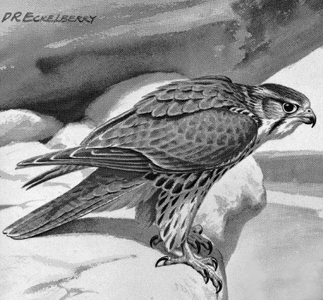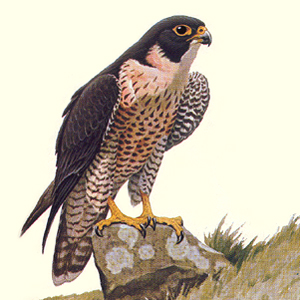|
|
Prairie
Falcon
Watercolor
Don R. Eckelberry
from Eagles, Hawks and Falcons
of the World (1968)
Brown and Amadon,
McGraw-Hill, New York.
|
|
Peregrine Falcon
Watercolor
Don R. Eckelberry
from Eagles, Hawks and Falcons
of the World (1968)
Brown and Amadon,
McGraw-Hill, New York.
|
|
The Prairie Falcon is smaller more slender, and
more maneuverable in flight than the Peregrine Falcon, but less adapt
as a hunter, specializing on prey usually caught near the ground.
The Peregrine Falcon, known for its dramatic
stoops, served as an icon for the hazards of DDT and other environmental
pollutants as declines from eggshell thinning led to classifying
the bird as endangered in 1970. By 1975 the North American population
was reduced to 159 known nesting pairs. After 29 years of federal
protection and ceaseless efforts of the Peregrine Fund, the University
of Minnesota's Raptor Center and the University of California's
Santa Cruz Predatory Bird Research Group, the population grew to
1650 pairs by 1997, and was removed from the Endangered Species
List in 1999. Monitoring will continue for 13 years, determining
the population status of at least two falcon generations.
Stanford Note: One does not expect to see
the Prairie Falcon on campus. So rare is its presence, that sightings
(date, place, time, activity) are especially welcome. It has long
been rumored that Peregrine can be seen at Hoover Tower, but there
are no official records.
|

